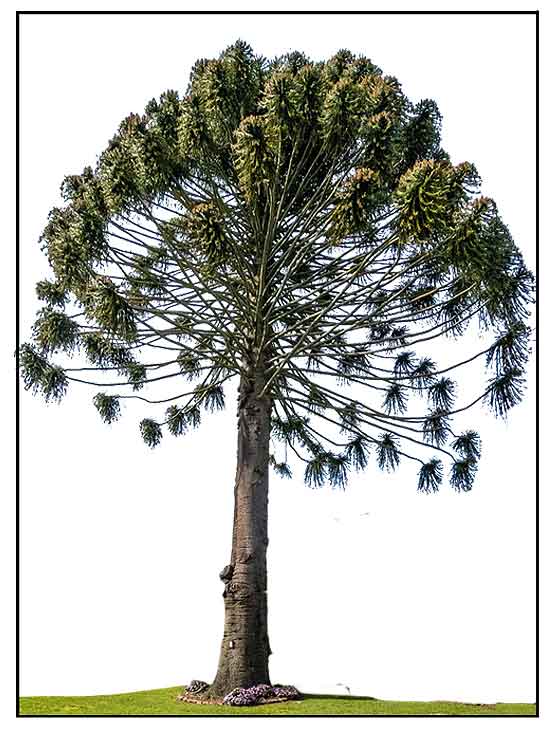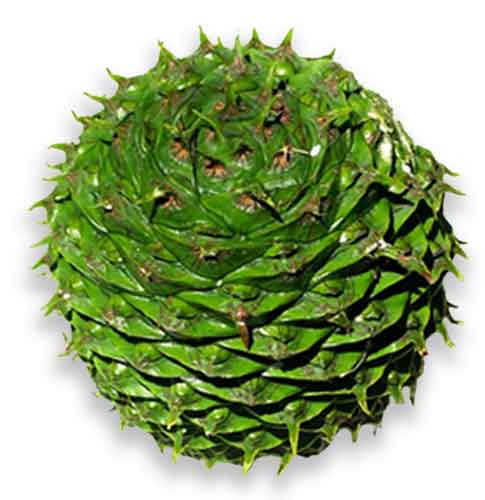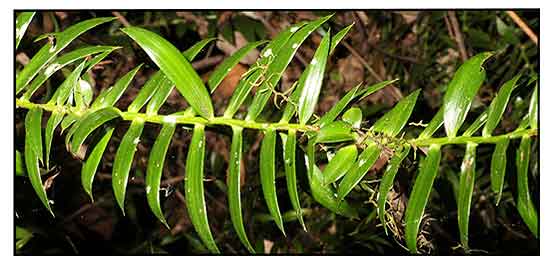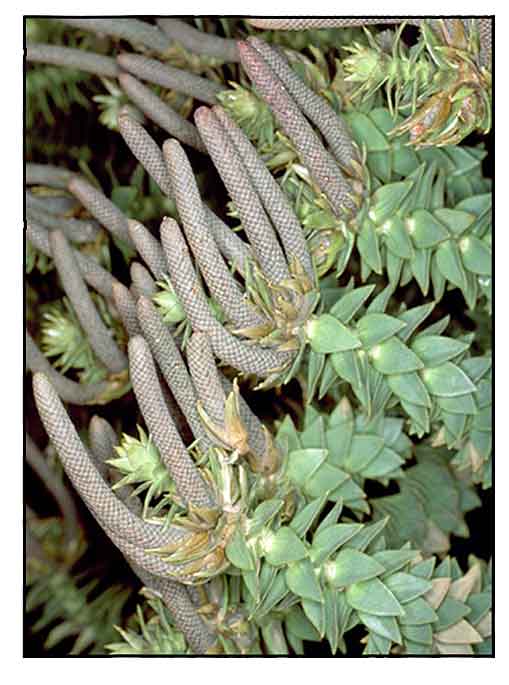 Gen info Gen info
- Araucaria bidwillii, commonly known as bunya pine, is a large evergreen coniferous tree in the family Araucariaceae. (2)
- The species was described by the English botanist William Jackson Hooker in 1843, based on material collected by John Carne Bidwill in 1842. (2)
- Etymology: The genus name Araucaria derives from the Spanish word Araucania, the name of the area in Chile where the first species of the genus originated; or, alternatively, from the Spanish word Araucanos for the original inhabitants of the area. The specific epithet bidwillii honors Bidwill, for his work on collecting specimens.
- Arauco is a
province of southern Chile, and the native habitat of A. bidwillii.
- The edible cones were an important food source for native Australian. To Aboriginal families the trees are hereditary personal property, which is passed down from pass down from generation to generation. The rights to collect seeds from certain trees is claimed by individual families, the right passed on from father to son. The cones become festive and edible offerings in aboriginal ceremonies of marriage, settlement of disputes, and trade. (2)
Botany
• Araucaria bidwillii is a large evergreen coniferous tree growing to a height of 50 m (160 ft) with a single unbranched trunk up to 1.5 m (4 ft 11 in) diameter, which has dark brown or black flaky bark. Branches are produced in whorls at regular intervals along the trunk, with leaf-bearing branchlets crowded at their ends. Branches are held more or less horizontally – those towards the top of the trunk may be  somewhat ascending, those on the lowest section of the trunk may be somewhat drooping, an arrangement that gives the tree a very distinctive egg-shaped silhouette. Leaves are small and rigid with a sharp tip which can easily penetrate the skin, narrowly triangular, broad at the base and sessile (without a stem), up to 5 cm (2.0 in) long by 1 cm (0.39 in) wide with fine longitudinal venation, glossy green above and paler underneath. Leaf arrangement is both is both distichous and decussate (referred to as secondarily distichous) – that is, one pair of leaves are produced on the twig opposite each other, and the next pair above is rotated around the twig 90° to them, and so on. Cones are terminal, the male (or pollen) cone is a spike up to 20 cm (7.9 in) long which matures around October to November. Female (or seed) cone is much larger, reaching up to 30 cm (12 in) long and 20 cm (7.9 in) wide, which is roughly equivalent to a rugby ball. At maturity, which occurs from December through to March, female cones are green with 50–100 pointed segments, each of which encloses a seed, and they can weigh up to 10kg. Both seed and pollen cones are some of the largest of all conifer species. Seeds are edible, measuring between 2.5 cm (0.98 in) and 5 cm (2.0 in) long and are ovoid to long-elliptic. somewhat ascending, those on the lowest section of the trunk may be somewhat drooping, an arrangement that gives the tree a very distinctive egg-shaped silhouette. Leaves are small and rigid with a sharp tip which can easily penetrate the skin, narrowly triangular, broad at the base and sessile (without a stem), up to 5 cm (2.0 in) long by 1 cm (0.39 in) wide with fine longitudinal venation, glossy green above and paler underneath. Leaf arrangement is both is both distichous and decussate (referred to as secondarily distichous) – that is, one pair of leaves are produced on the twig opposite each other, and the next pair above is rotated around the twig 90° to them, and so on. Cones are terminal, the male (or pollen) cone is a spike up to 20 cm (7.9 in) long which matures around October to November. Female (or seed) cone is much larger, reaching up to 30 cm (12 in) long and 20 cm (7.9 in) wide, which is roughly equivalent to a rugby ball. At maturity, which occurs from December through to March, female cones are green with 50–100 pointed segments, each of which encloses a seed, and they can weigh up to 10kg. Both seed and pollen cones are some of the largest of all conifer species. Seeds are edible, measuring between 2.5 cm (0.98 in) and 5 cm (2.0 in) long and are ovoid to long-elliptic.
Distribution
- Cultivated, not naturalized.
- Native to Queensland.
 Constituents Constituents
- Hydrodistilation study to extract oil from oleoresin of A. bidwillii
showed % yield of 0.13% v/w with characteristic aroma. GC-MS analysis of oleoresin essential oil yielded 17 secondary metabolites (90.78% of total). Monoterpene hydrocarbons represented the major chemical class, followed by oxygenated monoterpenes and sesquiterpenes hydrocarbons. The resin oil was enriched mainly with α-pinene (63.4%), nonane (5.21%), and trans-3-caren-2-ol (4.37%). In comparison beyerene, transnerolidol, and γ-elemene in concentrations of 35.65%, 13.66%, and 6.09%, respectively, are major components of oil of Egyptian A. bidwillii leaves. (see study below) (7)
Properties
- Studies have suggested CNS depressant, anti-inflammatory, analgesic, antioxidant, antiulcer, gastroprotective, anti-Helicobacter pylori, properties.
Parts used
Bark, leaves, oil.
 Uses Uses
Edibility
- Kernels are edible: The tough protective shell splits when boiled or put in a fire. The kernel's flavor is compared to chestnut and cooked potato, although less intense in aroma and flavor.
- In Australia, seeds are eaten roasted as a snack.
Folkloric
- In South Africa bark used for treatment of amenorrhea: One tablespoonful of grated bark is poured in about 750 cc of cold water, infused for a day, and taken 4 tablespoons at a time; also used as body wash and steam wash. (6)
Others
- Wood: Very much like Araucaria cunninghamii, pale pinkish in color, even in texture, with faint growth rings, and a density of 520 kg/cubic m. (8) Used for interior work.
-
Resin: Resin exuding from wounds is hard, brittle, and with a pleasant odor. Used for making incense, perfumes, and unguents. (5)
- Ornamental: Of commercial value as a Christmas tree. In South-East Asia, mainly planted as an ornamental tree. (5)
- Services: As shade and shelter; can be planted as a windbreak. (8)
Studies
• Analgesic / Anti-Inflammatory / Neuropharmacologic Effects / Leaf and Oleoresin: Study of leaf and oleoresin fractions of alcoholic and petroleum ether extracts of Araucaria bidwillii exhibited significant prolongation of pentobarbitone sleeping time at doses of 300 and 100 mg/kbw respectively in mice, with the effect more pronounced for oleoresin than the leaf extracts. The two extracts also showed analgesic effect by writhing method, comparable to aspirin, the effect higher in oleoresin than leaf extracts. Both extracts showed high anti-inflammatory effect by cotton pellet granuloma method, comparable to phenylbutazone. (3)
• Anti-Nociceptive / Anti-Inflammatory / Leaves: Study evaluated the effect of alcoholic extracts of leaf from A. bidwillii in experimental models of pain and inflammation, using doses of 100, 200, and 300 mg/kg. At 300 and 200 mg/kg, the leaf extract showed significant reduction in acetic acid writhings i mice with maximum effect of 65.1% reduction at 300 mg/kg. In hot plate method, percentage inhibition was 81.69% and 66.1% with the test doses, respectively. Effect was comparable to acetylsalicylic acid at 100 mg/kg (91.52%). In doses of 100, 200, and 300 mg/kg, the alcoholic extract showed significant inhibition in carrageenan (18.61, 32.12, and 45.64%) and serotonin (32.81, 38.68, and 40.75%) induced paw edema in rats, comparable to indomethacin 5 mg/kg (68.51 and 63.18%). The anti-inflammatory and analgesic effects may be mediated via both peripheral and central mechanisms. (4)
• Gastroprotective / Anti-Ulcer / Anti-Helicobacter pylori / Oleoresin Essential Oil: Study evaluated the essential oils from oleoresins of two Araucaria species, A. bidwillii and A. heterophylla for gastroprotective, anti-inflammatory, antioxidant, and anti-Helicobacter pylori potentials. Both species showed pronounced inhibitory effect on Helicobacter pylori activity in vitro. Gastroprotective effects were assessed in vivo in ethanol-induced gastric ulcer model in rats evaluating inflammatory cytokines, oxidative stress, and NF-kB biomarkers in stomach tissues, along with ulcer index and percentage ulcer protection. Araucaria bidwillii exhibited gastroprotective effects superior to A. heterophylla via modulation of oxidative stress/NFkB/inflammatory cytokines. (see constituents above) (7)
Availability
- Cultivated.
- Seeds in the cybermarket.
|

![]()







